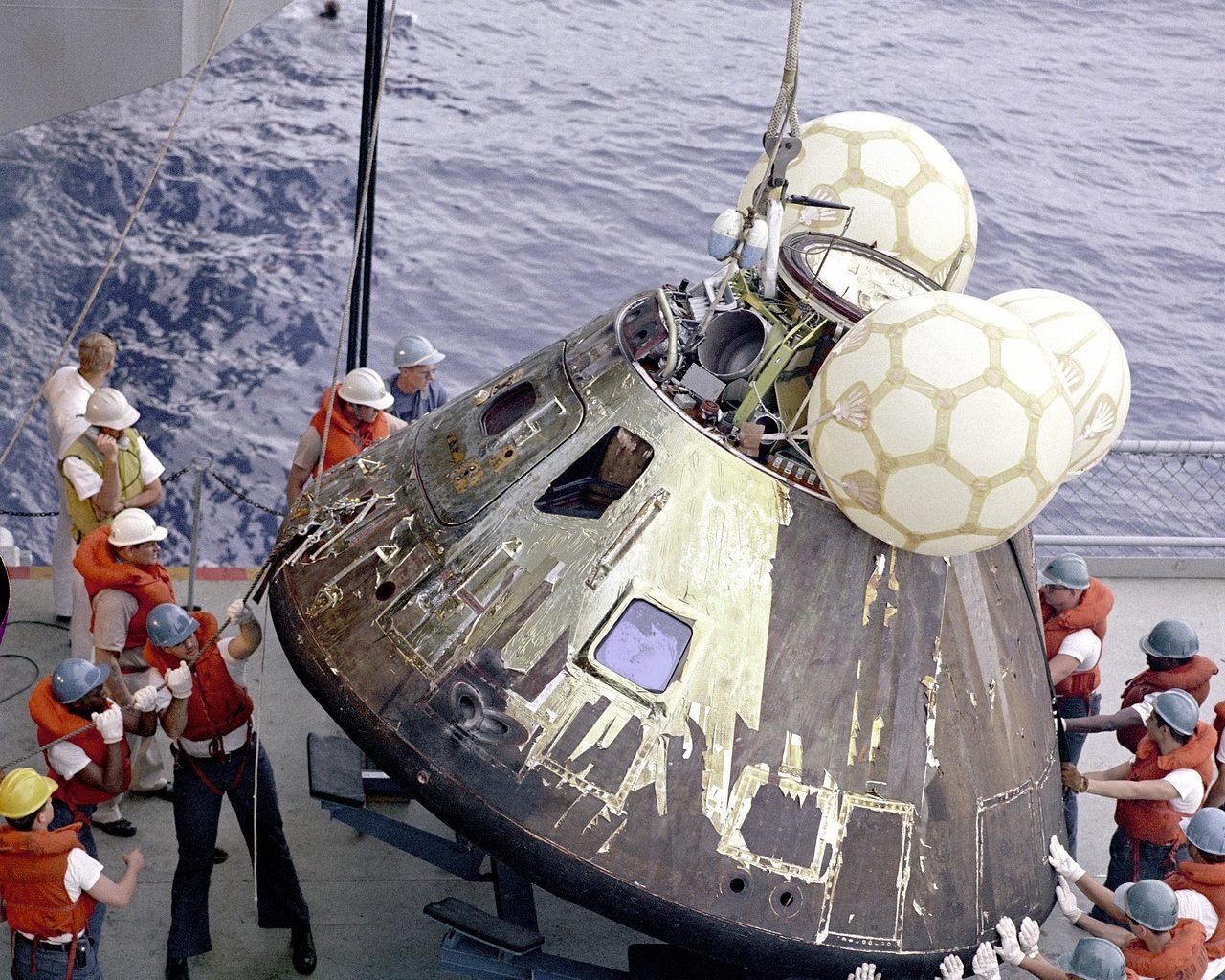
The Apollo program was launched by NASA with the grand vision of sending astronauts to the Moon, conducting scientific research and ultimately, landing humans on the lunar surface. The missions were designed to achieve specific scientific and exploration goals while pushing the boundaries of human spaceflight. The mission was planned to be the third lunar landing following the successful missions of Apollo 11 and Apollo 12. The seventh crewed mission in NASA’s Apollo program, launched on April 11, 1970, with the ambitious goal of landing on the Moon and exploring the Fra Mauro (Fra Mauro is a geographical region on the Moon located near the Moon’s equator on the side facing Earth. It is named after the Italian cartographer and monk Fra Mauro) region. However, fate had other plans, and what ensued was a harrowing tale of survival, ingenuity, and determination. In this blog, we will delve into the details of Apollo 13, exploring its initial objectives, the critical in-flight incident that altered its course, the challenges faced by the crew, and the remarkable teamwork that ultimately led to their safe return to Earth.
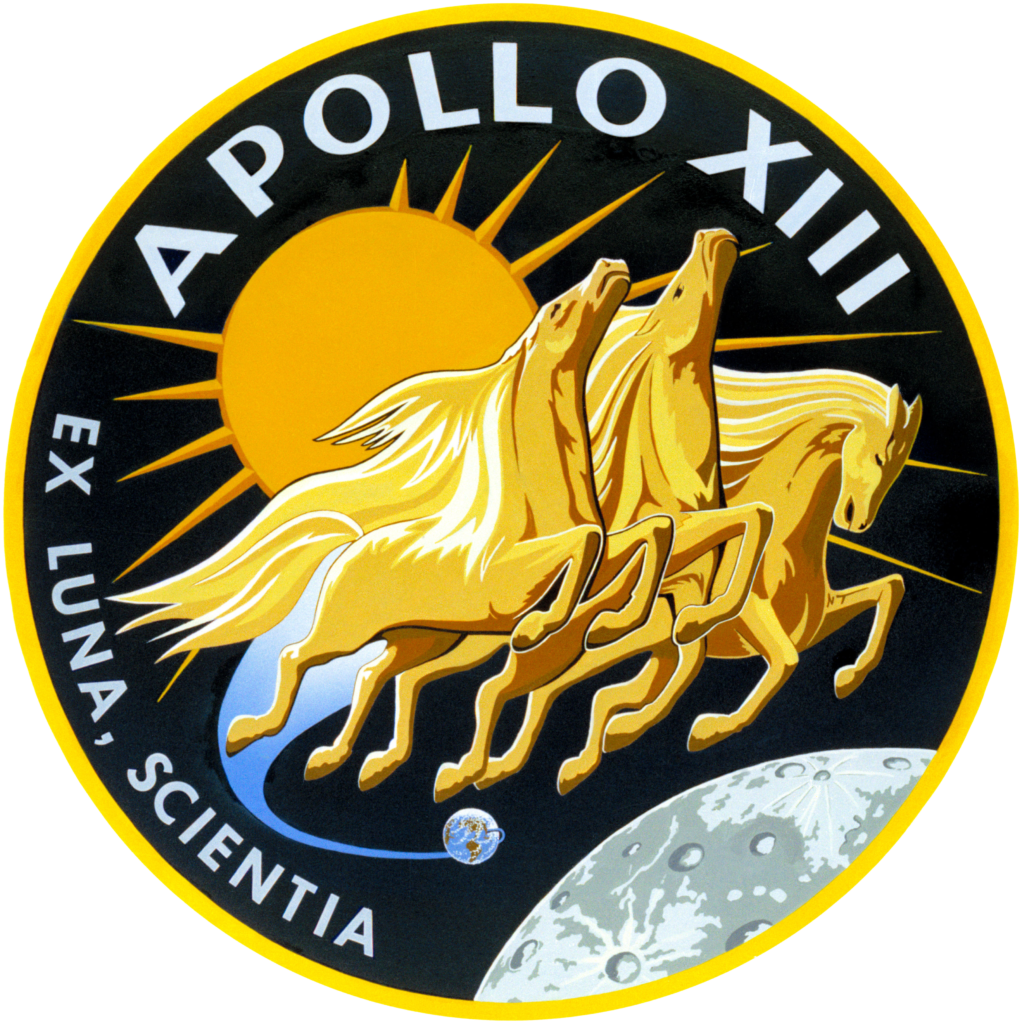
I. Objectives and Crew of Apollo 13:
The plan was for the Lunar Module (LM) to touch down on the lunar surface while the Command Module (CM) remained in orbit around the Moon. This setup allowed the crew to conduct scientific experiments, collect lunar samples, and explore the lunar terrain during their surface activities.
The Apollo 13 crew consisted of three astronauts, each of whom brought their unique expertise to the mission:
Commander James A. Lovell Jr.: James Lovell was a highly experienced astronaut with two previous spaceflights under his belt—Gemini 7 and Gemini 12. He was chosen as the commander of Apollo 13 due to his leadership skills and extensive experience.
Command Module Pilot John L. Swigert Jr.: Initially, Thomas K. Mattingly was designated as the Command Module Pilot, but he was replaced a few days before the launch due to exposure to German measles. John Swigert, a skilled astronaut, was brought in as his replacement. Although it was his first spaceflight, Swigert had undergone rigorous training and preparations for a backup role.
Lunar Module Pilot Fred W. Haise Jr.: Fred Haise was the Lunar Module Pilot and a highly capable astronaut. He had not flown in space before but had served as the backup Lunar Module Pilot for Apollo 8 and Apollo 11. His knowledge of the LM systems and lunar procedures was instrumental in this particular mission.
The crew of Apollo 13 underwent extensive training and simulations to prepare for their lunar mission. They practiced in simulators and participated in realistic mission scenarios to familiarize themselves with the spacecraft’s systems, conduct lunar surface activities, and respond to emergencies.
The crew worked closely with mission planners, scientists, and engineers to understand the scientific goals of the mission and how to achieve them efficiently and safely. The training was physically and mentally demanding, ensuring that the astronauts were ready for the challenges of space travel and lunar exploration.
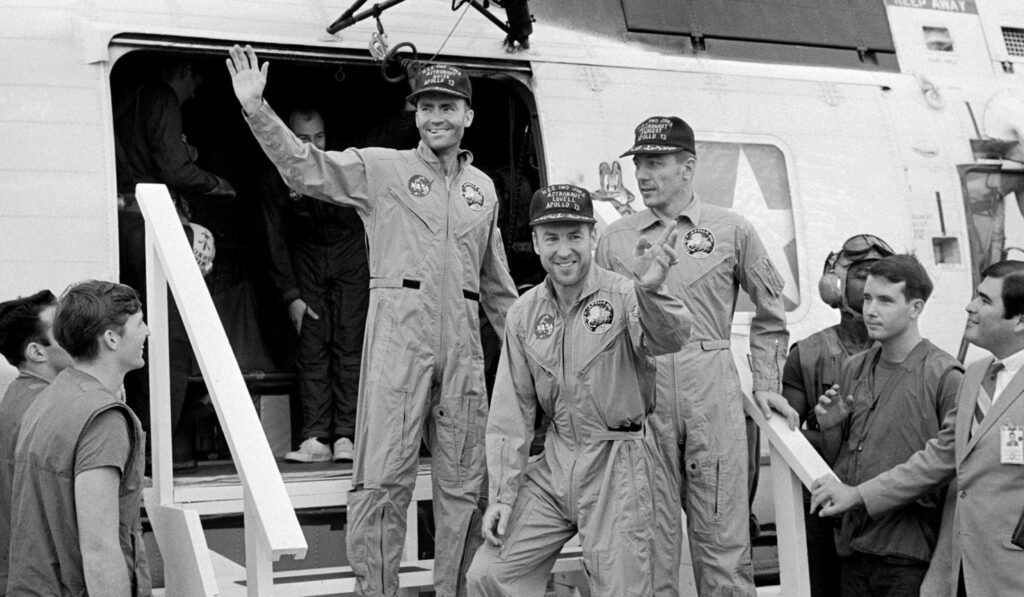
II. Launch and Early Mission Phases:
On the morning of April 11, 1970, Apollo 13 stood ready on Launch Complex 39A at the Kennedy Space Center in Florida. The Saturn V rocket, the most powerful rocket ever built, was poised to propel the crew on their journey to the Moon. The world watched with anticipation and excitement as the countdown clock approached zero.
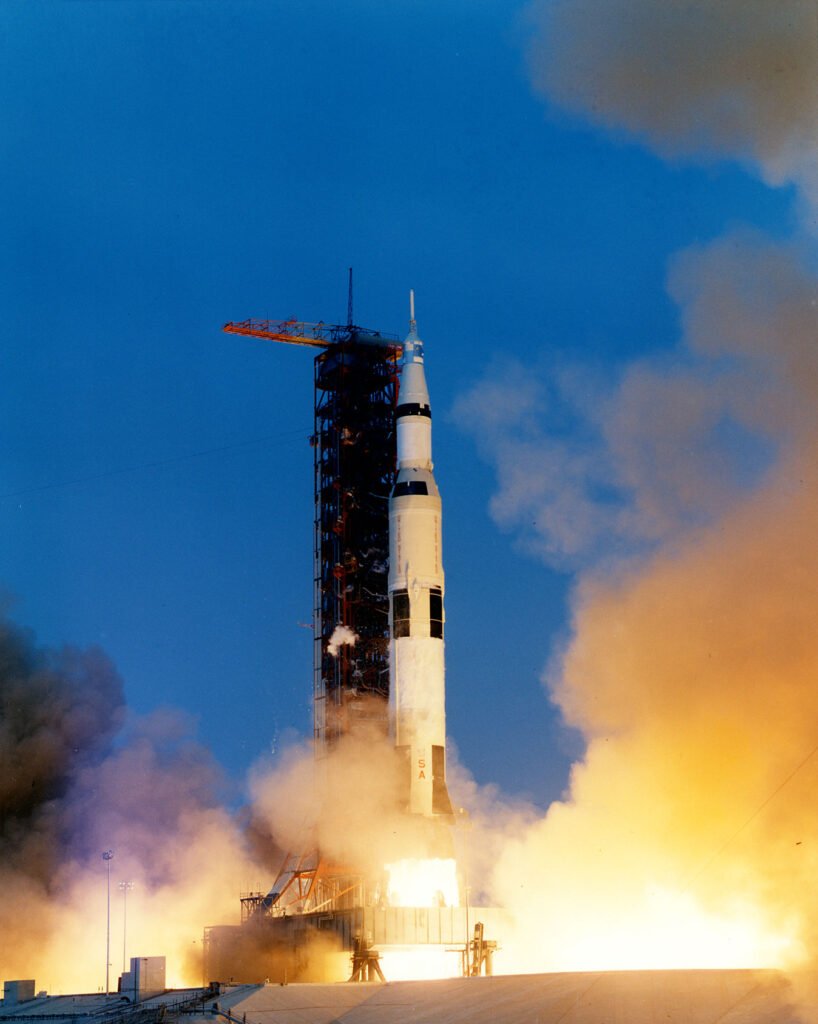
Kennedy Space Center launches Apollo 13 on April 11, 1970.
At precisely 2:13 PM Eastern Standard Time, the Saturn V’s engines ignited, unleashing a thunderous roar. With an awe-inspiring display of power, Apollo 13 lifted off from the launch pad and began its ascent toward space. The three astronauts on board, Commander James Lovell, Command Module Pilot John Swigert, and Lunar Module Pilot Fred Haise, experienced the intense forces of launch as they hurtled skyward.
The early stages of the mission proceeded smoothly, as the spacecraft soared into Earth’s orbit. The Command Module (CM), named Odyssey, and the Lunar Module (LM), named Aquarius, were successfully separated from the third stage of the Saturn V rocket. The crew settled into their routine and performed various checks to ensure that all systems were functioning correctly.
After orbiting the Earth two and a half times, Apollo 13 was ready for the crucial Translunar Injection (TLI) burn. The TLI burn was a critical engine firing that propelled the spacecraft out of Earth’s orbit and set it on a trajectory toward the Moon. The TLI was executed flawlessly, and Apollo 13 was en route to its destination.
As the spacecraft traveled through space, small course corrections were made to refine its trajectory and ensure a precise lunar approach. These maneuvers were essential to aligning the spacecraft for a successful lunar orbit insertion.
III. The Oxygen Tank Explosion – A Critical Turning Point:
Approximately 56 hours into Apollo 13’s mission, while the spacecraft was about 205,000 miles (330,000 kilometers) from Earth and on its way to the Moon, an unforeseen and catastrophic event occurred that would forever alter the course of the mission. On April 13, 1970, the tranquility of space was shattered by the explosion of an oxygen tank in the service module.
The explosion was triggered by a combination of factors. One of the oxygen tanks in the service module, designated as “tank 2,” had been previously installed in the Apollo 10 spacecraft but was removed and returned to the manufacturer due to issues with its internal thermostatic switches. These switches were used to maintain the tank’s temperature during various mission phases. Before Apollo 13’s launch, the tank was mistakenly installed back into the Apollo 13 service module, despite its known issues.
As the spacecraft neared the Moon, the crew was conducting a routine procedure of stirring the cryogenic oxygen tanks in preparation for their lunar landing. The stirring was meant to prevent stratification of the liquid oxygen, ensuring that the astronauts had a constant and reliable supply of breathable oxygen.
Unfortunately, an electrical fault in the heating system caused the insulation in the oxygen tank to overheat, leading to the ignition of the tank’s contents. The resulting explosion was devastating, severely damaging the service module and leading to a rapid loss of electrical power, heat, and water supply in the command module, which housed the crew.
The lunar landing had to be aborted immediately due to the critical situation. With the service module rendered inoperable, the command module became the crew’s primary life support system. However, it was not designed to sustain the crew during the lunar landing or for the extended return journey to Earth.
The crew’s focus shifted from conducting lunar surface activities to ensuring their own survival. They immediately took stock of their resources and assessed the situation with the help of mission control at NASA’s Johnson Space Center.
IV. Life-Threatening Challenges:
The crew of Apollo 13 found themselves in an unprecedented and perilous situation after the oxygen tank explosion. Stranded in space and facing critical shortages of essential resources, they had to confront a series of life-threatening challenges that put their survival skills and the ingenuity of mission control to the ultimate test.
The explosion in the service module severely damaged the command module (CM), which was the primary living and working space for the crew during most of the mission. The CM housed essential life-support systems, including oxygen, water, and electrical power. With the CM rendered inoperable and unsafe for habitation, the crew was forced to abandon it and seek refuge in the Lunar Module (LM).
The Lunar Module (LM), named Aquarius, was intended to be used solely for the lunar landing and the return to the command module after exploring the Moon’s surface. It was not designed to accommodate three astronauts for an extended duration. The LM had limited resources, such as oxygen, water, and power, primarily allocated for the two astronauts intended to walk on the Moon.
With three astronauts on board, the crew had to drastically ration their supplies to extend their time in the LM and ensure their survival. They implemented strict conservation measures, reducing power usage, adjusting temperature settings, and limiting water consumption. This situation presented a constant challenge to maintain a delicate balance between preserving life-support systems and conserving resources for the journey home.
The explosion also affected the spacecraft’s electrical power supply, forcing the crew to rely on backup systems. The shortage of power posed a significant challenge as it limited the functioning of critical systems, communications, and navigation equipment. The crew had to carefully manage their power usage, ensuring that vital systems remained operational while conserving enough power for their return trajectory to Earth.
Additionally, the lack of power also affected communication with mission control. The crew had to rely on backup radio systems, and their ability to communicate with Earth was limited during certain parts of their journey. This added to the tension and uncertainty surrounding the mission.
The Lunar Module was designed to accommodate two astronauts for a relatively short period. With all three crew members now residing in the cramped confines of the LM, the living conditions became extremely challenging. There was limited space for movement, and the astronauts had to find ways to coexist and work efficiently in a confined environment.
The psychological strain on the crew was significant as well. They were thousands of miles away from Earth, facing life-threatening challenges, and cut off from the rest of humanity. The uncertainty of their situation and the knowledge that any misstep could have dire consequences added immense pressure to an already daunting scenario.
Throughout their journey, the crew demonstrated exceptional resilience, resourcefulness, and teamwork. They worked closely with mission control to devise solutions to their problems and to execute critical maneuvers that would determine their path back to Earth. The bond between the astronauts and the collaboration with mission control were crucial in navigating the challenges they faced.
V. Ingenious Solutions and Collaborative Efforts:
The life-threatening situation faced by the crew of Apollo 13 demanded quick thinking, creative problem-solving, and exceptional teamwork. Both the astronauts aboard the spacecraft and the teams at NASA’s mission control center in Houston, Texas, rose to the challenge, developing ingenious solutions and collaborating tirelessly to overcome the numerous obstacles they encountered.
With the explosion in the service module severely limiting the spacecraft’s power supply, the crew had to take immediate measures to conserve energy. They shut down non-essential systems, dimmed lights, and carefully managed the spacecraft’s power consumption to ensure the essential life-support systems remained operational.
Likewise, the crew had to conserve their limited supply of oxygen and water to sustain their journey. They adapted to using the Lunar Module’s life-support systems, which were primarily designed for two astronauts for a short duration, to support all three crew members for an extended period. By meticulously rationing their resources, they ensured they had enough to last until their return to Earth.
The Lunar Module (LM) was originally intended to be used solely for the lunar landing and was not designed for the return journey to Earth. However, the ingenious minds at NASA devised a plan to adapt the LM into a “lifeboat” to carry the crew safely back home.
The LM’s descent engine, intended for landing on the Moon, was repurposed for critical course corrections. By firing the descent engine at precisely calculated intervals, the crew adjusted their trajectory to slingshot around the Moon, using its gravitational pull to propel them back towards Earth. This innovative maneuver, known as the “lunar gravity assist,” was a crucial part of their trajectory back to Earth.
The lack of power and the challenges of spaceflight meant that the crew and mission control had to rely on their ingenuity to devise solutions with the limited resources at hand. They used the LM’s onboard systems creatively, maximizing their functionality to serve new purposes, such as improvised CO2 scrubbers to remove excess carbon dioxide from the cabin.
In addition to their resourcefulness, the crew relied on their extensive training and expertise to troubleshoot issues as they arose. They worked closely with mission control to develop procedures and execute critical maneuvers, all while facing the pressure and urgency of their situation.
Throughout the mission, mission control was in constant communication with the crew, providing guidance, support, and critical information. The teams at mission control performed numerous simulations to test and validate the procedures necessary for the safe return of Apollo 13. The collaborative efforts between the crew and mission control were vital in devising the best course of action and implementing the necessary steps to ensure the crew’s survival.
VI. Safe Return and Heroic Reception:
After nearly four days of intense challenges and ingenuity in space, the crew of Apollo 13 faced their final and most crucial hurdle – returning safely to Earth. Their journey home was fraught with uncertainties, but their determination and the dedication of mission control prevailed, leading to a triumphant safe return and a heroic reception.
As Apollo 13 approached Earth, one of the greatest concerns was the integrity of the Command Module’s heat shield. The explosion had damaged the Service Module, which typically shielded the Command Module during re-entry. The uncertainty surrounding the heat shield’s condition created anxiety among the mission control team and the worldwide audience following the mission.
The crew prepared for re-entry by transferring from the Lunar Module back to the Command Module, Odyssey, for their final journey home. Once safely back inside the Command Module, they jettisoned the Lunar Module, which had served as their lifeboat throughout the return journey.
On April 17, 1970, the Apollo 13 spacecraft began its descent into Earth’s atmosphere. The crew endured a period of radio silence as the spacecraft experienced intense heat and friction during re-entry. The tension in mission control was palpable as they anxiously awaited communication from the spacecraft.
Finally, contact with Apollo 13 was reestablished, and the spacecraft emerged from the fiery re-entry phase. The crew had survived the critical re-entry process and they were safely hurtling towards the Pacific Ocean for their splashdown.
As Apollo 13 descended towards the Pacific Ocean, the USS Iwo Jima, a United States Navy ship stationed in the recovery area, awaited the crew’s arrival. The astronauts splashed down at 1:07 PM Eastern Standard Time, about 4 kilometers (2.5 miles) from the recovery ship.
The USS Iwo Jima promptly reached the splashdown site and successfully retrieved the crew and their spacecraft from the ocean. The safe recovery of the astronauts marked the end of their epic journey of survival and resourcefulness.
The safe return of the Apollo 13 crew was met with a hero’s welcome and immense relief worldwide. The crew members, Commander James Lovell, Command Module Pilot John Swigert, and Lunar Module Pilot Fred Haise were hailed as heroes for their bravery, quick thinking and composure during the crisis.
They returned to a hero’s reception, celebrated not only for their safe return but also for their remarkable achievements in overcoming unprecedented challenges in space. The crew’s story of survival and triumph resonated with people around the world becoming a symbol of human resilience and the indomitable spirit of exploration.
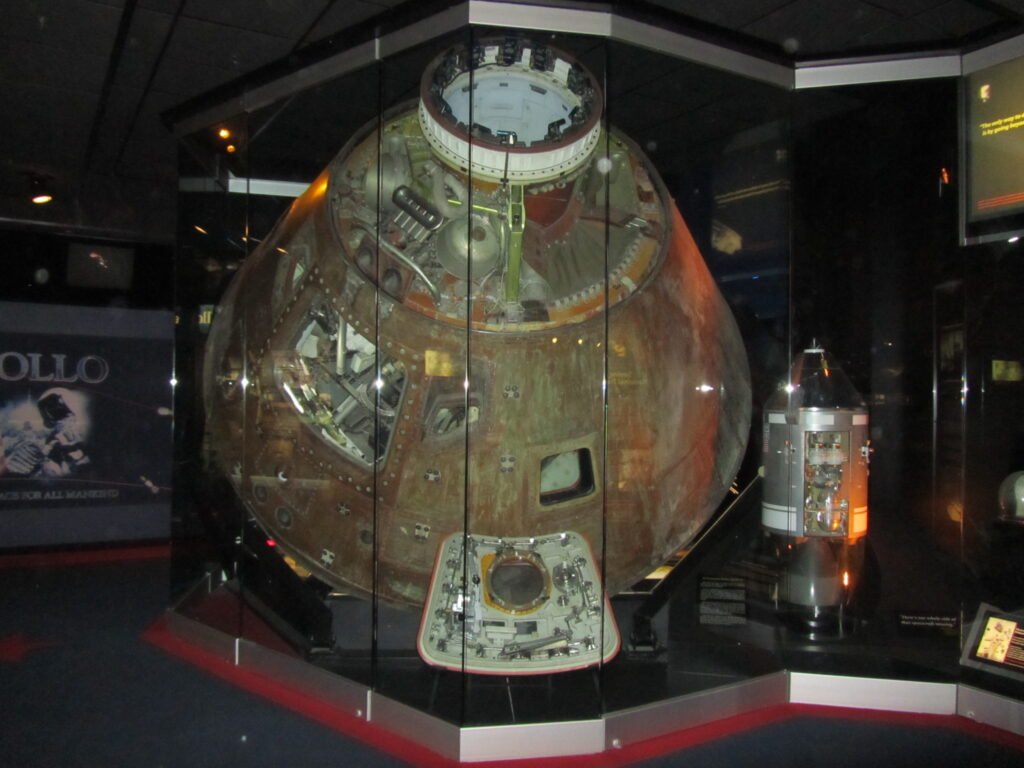
VII. Legacy and Lessons Learned:
The Apollo 13 mission remains one of the most memorable and impactful events in the history of space exploration. It not only demonstrated the incredible resilience and resourcefulness of the astronauts and mission control but also left a lasting legacy that continues to influence space missions and human endeavors beyond Earth. The lessons learned from Apollo 13 have profoundly shaped subsequent space missions and NASA’s approach to space exploration.
Apollo 13 brought to the forefront the inherent risks and dangers associated with space travel. The explosion in the service module served as a stark reminder that even meticulously planned missions could encounter unforeseen challenges. It underscored the need for continuous vigilance, contingency planning, and the ability to respond effectively to unexpected situations.
Following the Apollo 13 mission, NASA made significant efforts to enhance safety measures and redundancy in spacecraft systems. Design changes were implemented to minimize the risks of similar incidents in future missions. The focus on thorough testing, improved procedures, and stringent quality control measures became paramount in subsequent space missions.
The crisis on Apollo 13 highlighted the importance of robust contingency planning. Mission planners and engineers worked tirelessly to develop alternative procedures and improvised solutions in real-time. NASA emphasized the importance of having backup plans and training astronauts to handle a wide range of emergencies, ensuring they were well-prepared to respond to unexpected situations.
The successful resolution of the Apollo 13 crisis demonstrated the significance of effective teamwork and communication. The collaborative efforts between the astronauts and mission control were fundamental to devising solutions and making critical decisions. The open flow of information and seamless coordination between ground teams and the crew proved instrumental in overcoming the challenges faced during the mission.
The Apollo 13 mission exemplified the human spirit of ingenuity, resilience, and determination. The crew and mission control showed incredible adaptability and resourcefulness in the face of adversity, finding innovative solutions to complex problems with limited resources. Their unwavering commitment to the mission’s success stands as an inspiring example of human capabilities.
The events of Apollo 13 captivated the world’s attention, sparking a renewed sense of wonder and fascination with space exploration. The heroic efforts of the crew and the successful return home resonated with people worldwide, instilling a profound sense of pride and accomplishment in humanity’s capacity to explore and overcome challenges in the pursuit of knowledge and exploration beyond Earth.
The challenges encountered during Apollo 13 provided invaluable lessons that furthered our understanding of space technology and its complexities. The lessons learned from the mission’s mishap led to advancements in spacecraft design, life-support systems, and the development of safer space travel practices. These advancements have since been incorporated into subsequent missions and have expanded our knowledge of space exploration.

Nice post….